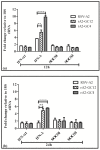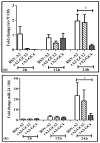The Central Conserved Region (CCR) of Respiratory Syncytial Virus (RSV) G Protein Modulates Host miRNA Expression and Alters the Cellular Response to Infection
- PMID: 28671606
- PMCID: PMC5620547
- DOI: 10.3390/vaccines5030016
The Central Conserved Region (CCR) of Respiratory Syncytial Virus (RSV) G Protein Modulates Host miRNA Expression and Alters the Cellular Response to Infection
Abstract
Respiratory Syncytial Virus (RSV) infects respiratory epithelial cells and deregulates host gene expression by many mechanisms including expression of RSV G protein (RSV G). RSV G protein encodes a central conserved region (CCR) containing a CX3C motif that functions as a fractalkine mimic. Disruption of the CX3C motif (a.a. 182-186) located in the CCR of the G protein has been shown to affect G protein function in vitro and the severity of RSV disease pathogenesis in vivo. We show that infection of polarized Calu3 respiratory cells with recombinant RSV having point mutations in Cys173 and 176 (C173/176S) (rA2-GC12), or Cys186 (C186S) (rA2-GC4) is associated with a decline in the integrity of polarized Calu-3 cultures and decreased virus production. This is accompanied with downregulation of miRNAs let-7f and miR-24 and upregulation of interferon lambda (IFNλ), a primary antiviral cytokine for RSV in rA2-GC12/rA2-GC4 infected cells. These results suggest that residues in the cysteine noose region of RSV G protein can modulate IFN λ expression accompanied by downregulation of miRNAs, and are important for RSV G protein function and targeting.
Keywords: CX3CR1; IFNλ; RSV; microRNAs; respiratory syncytial virus.
Conflict of interest statement
The authors declare no conflict of interest. The findings and conclusions in this report are those of the author(s) and do not necessarily represent the official position of the Centers for Disease Control and Prevention. The funding sponsors had no role in the design of the study; in the collection, analyses, or interpretation of data; in the writing of the manuscript, and in the decision to publish the results.
Figures





Similar articles
-
Effects of Alterations to the CX3C Motif and Secreted Form of Human Respiratory Syncytial Virus (RSV) G Protein on Immune Responses to a Parainfluenza Virus Vector Expressing the RSV G Protein.J Virol. 2019 Mar 21;93(7):e02043-18. doi: 10.1128/JVI.02043-18. Print 2019 Apr 1. J Virol. 2019. PMID: 30651356 Free PMC article.
-
CX3CR1 is an important surface molecule for respiratory syncytial virus infection in human airway epithelial cells.J Gen Virol. 2015 Sep;96(9):2543-2556. doi: 10.1099/vir.0.000218. Epub 2015 Jun 25. J Gen Virol. 2015. PMID: 26297201 Free PMC article.
-
Respiratory Syncytial Virus Uses CX3CR1 as a Receptor on Primary Human Airway Epithelial Cultures.PLoS Pathog. 2015 Dec 11;11(12):e1005318. doi: 10.1371/journal.ppat.1005318. eCollection 2015 Dec. PLoS Pathog. 2015. PMID: 26658574 Free PMC article.
-
Respiratory syncytial virus (RSV) evades the human adaptive immune system by skewing the Th1/Th2 cytokine balance toward increased levels of Th2 cytokines and IgE, markers of allergy--a review.Virus Genes. 2006 Oct;33(2):235-52. doi: 10.1007/s11262-006-0064-x. Virus Genes. 2006. PMID: 16972040 Review.
-
Contribution of respiratory syncytial virus G antigenicity to vaccine-enhanced illness and the implications for severe disease during primary respiratory syncytial virus infection.Pediatr Infect Dis J. 2004 Jan;23(1 Suppl):S46-57. doi: 10.1097/01.inf.0000108192.94692.d2. Pediatr Infect Dis J. 2004. PMID: 14730270 Review.
Cited by
-
Determining Immune and miRNA Biomarkers Related to Respiratory Syncytial Virus (RSV) Vaccine Types.Front Immunol. 2019 Oct 9;10:2323. doi: 10.3389/fimmu.2019.02323. eCollection 2019. Front Immunol. 2019. PMID: 31649663 Free PMC article.
-
Virus-like Particle Vaccine Expressing the Respiratory Syncytial Virus Pre-Fusion and G Proteins Confers Protection against RSV Challenge Infection.Pharmaceutics. 2023 Feb 27;15(3):782. doi: 10.3390/pharmaceutics15030782. Pharmaceutics. 2023. PMID: 36986643 Free PMC article.
-
Immunogenicity and protective efficacy of an RSV G S177Q central conserved domain nanoparticle vaccine.Front Immunol. 2023 Jun 29;14:1215323. doi: 10.3389/fimmu.2023.1215323. eCollection 2023. Front Immunol. 2023. PMID: 37457705 Free PMC article.
-
Immunopathology of RSV: An Updated Review.Viruses. 2021 Dec 10;13(12):2478. doi: 10.3390/v13122478. Viruses. 2021. PMID: 34960746 Free PMC article. Review.
-
Respiratory Syncytial Virus (RSV) G Protein Vaccines With Central Conserved Domain Mutations Induce CX3C-CX3CR1 Blocking Antibodies.Viruses. 2021 Feb 23;13(2):352. doi: 10.3390/v13020352. Viruses. 2021. PMID: 33672319 Free PMC article.
References
-
- Zhou H., Thompson W.W., Viboud C.G., Ringholz C.M., Cheng P.Y., Steiner C., Abedi G.R., Anderson L.J., Brammer L., Shay D.K. Hospitalizations associated with influenza and respiratory syncytial virus in the united states, 1993–2008. Clin. Infect. Dis. 2012;54:1427–1436. doi: 10.1093/cid/cis211. - DOI - PMC - PubMed
-
- Centers for Disease Control and Prevention (CDC) Respiratory syncytial virus activity—United States, July 2007–December 2008. MMWR Morb. Mortal. Wkly. Rep. 2008;57:1355–1358. - PubMed
LinkOut - more resources
Full Text Sources
Other Literature Sources
Research Materials
Miscellaneous

